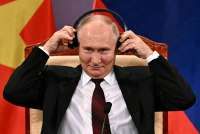'MAXIMUM PRESSURE'
Natanz is the centrepiece of Iran's enrichment programme, which Tehran says is for peaceful purposes. Western intelligence agencies and the U.N.'s nuclear watchdog (IAEA) believe it had a coordinated, clandestine nuclear arms programme that it halted in 2003. Tehran denies ever seeking nuclear weapons.
Iran agreed to curb its nuclear programme in exchange for the removal of most international sanctions in a deal reached between Tehran and six world powers in 2015.
But Iran has gradually reduced its commitments to the accord since U.S. President Donald Trump's administration withdrew from the deal in 2018 and reimposed and intensified sanctions that have battered Iran's economy.
The deal only allows Iran to enrich uranium at its Natanz facility with just over 5,000 first-generation IR-1 centrifuges, but Iran has installed new cascades of advanced centrifuges.
Iran, which says it will not negotiate as long as sanctions remain in place, has repeatedly vowed to continue building up what it calls a defensive missile capability run by the Revolutionary Guards, in defiance of Western criticism.
Israel has backed Trump's "maximum pressure" policy on Tehran aimed at forcing it to agree a new deal that puts stricter limits on its nuclear work, curbs its ballistic missile programme and ends its regional proxy wars.
In 2010, the Stuxnet computer virus, widely believed to have been developed by the United States and Israel, was discovered after it was used to attack Natanz.
The Natanz Fuel Enrichment Plant (FEP), Iran's main uranium enrichment site which is mostly underground, is one of several Iranian facilities monitored by inspectors of the International Atomic Energy Agency (IAEA), the U.N. nuclear watchdog.
The IAEA said on Friday that the location of the fire did not contain nuclear materials and that none of its inspectors was present at the time.
/2017/04/07/1690700941p.jpg)









